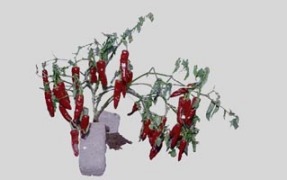Resham Patto _ New Chilli Variety
Eighty-year old Alidada is well known in his village for his vast experience in farming. He has gained great insights through trial and error in a lifelong process of learning. Father of eleven children, Alidada has become some sort of an agriculture consultant. Aided by three of his sons, Alidada cultivates a farm of 100 acres (40 ha) and maintains a systematic record of every crop he has ever planted on his land since 1976. This record includes details like date of sowing and harvesting, fertilizers used, management practices, yield, profit obtained and so on. It has become routine for Alidada and his sons to scrutinize the previous year's record while planning for the subsequent season.
His knowledge and expertise can be attributed to his passion for maintaining records and documenting the results of the trials he undertakes. It is this passion that brought him success in developing a new planting method for groundnut (Arachis hypogaea) and in developing new variety of chillies.
Alidada has been the Head of Chikori Sangh in Jamnagar and for several years, he has been the Director of the District Co-operative Bank. Shri. A B Vajpayee, then a Member of Parliament, visited Alidada's farm in 1990 and was thoroughly impressed with his work. Alidada was honoured with Gujarat's Sardar Krishi Research Award. One of his sons, Bhadurbhai, was conferred with an award in 1999 by the Agriculture Department, Gandhinagar for improving the water level in the village wells through a novel rain-harvesting method. Alidada has registered an Ayurvedic cooperative whose members cultivate medicinal plants. They are on the look out for someone to market their produce.
In the wake of the severe cyclone that devastated parts of coastal Gujarat in 1980, outbreak of diseases ruined the groundnut crop in the Abhavani family farm. The family decided to invest in a crop that fetched them money. They spotted a promising chilli variety in the market and bought five kg of it to experiment with. Chillies are a lucrative cash crop. Not knowing details of cultivating chillies, Alidada and his sons fumbled for three years trying to grow it in a 0.7 hectare piece of land, without much success. They decided to consult farmers in Dwarka. They sowed the seeds brought from Dwarka but discovered them to be a mixture of several varieties of chillies. Soon, they also realized that they had sown the crop a little ahead of time. The nursery had been prepared in May and the seedlings were transplanted after the first rains. As a result, the plants bore fruits early but the fruit rot rate was high. In 1983, they decided to conduct a study to decide the best time for sowing. They divided the field into three plots. In the first plot, the seeds were sown early, a little later in the next plot and much later in the last one. The best results in terms of yield were when the nursery was prepared in July and the seedlings transplanted in August. At that time, they had sown chillies in 2.4 hectare land and reaped a profit of Rs 1.5 lakh. Today, Alidada and his sons produce Rs 25 lakh worth of chillies a year. The findings of their study also revealed January-February to be the right time to harvest the fruits. Once it happened that the Abhavani family was busy with other work and could not harvest the crop in January. While irrigating an adjacent plot of bajra (pearl millet), some water had seeped into the chilli field and the fruits had remained unharvested for a few more days. They then noticed that the plants started flowering again! The second crop of chillies was ready for harvest in March-April. Usually, this is the time when green chillies are in severe short supply in the market. Therefore, they could sell their produce realising much higher price than usual. By harvesting the same crop twice, Alidada and his sons increased their productivity and their profit. It took Abhavani family three years to select the new variety and even today the process of selection is on. The Abhavanis are continually on the look out for better and better quality fruits. They choose healthy plants with thick skin and black veins and sow the seeds of only healthy and hardy plants.
The Resham patto has a smooth, thick skin with a silk-like sheen. The fruit is five to seven inches (125 to 175 mm) long and about two inches (50 mm) wide. The skin is quite tough and does not crack upon drying. Its colour is deep red though it is not too pungent. The plant grows to a height of 2-1/2 to 3 feet (75 to 100 cm) and each plant has 6 to 10 branches. The plant bears 100 to 150 fruits and each fruit contains 120 to 140 seeds. The usual yield of red chilli fruits is 1250-1650 kg/ha and the maximum yield ever reached is 3000 kg/ha. The yield of green chillies is 3300-4200 kg/ha. Green chillies can fetch Rs 10 to Rs 15 per kg, while red chillies sell for Rs 120 per kg in the market.Flowering takes place 45 days after transplanting. Fruits start appearing in October and mature in January-February. It takes five months for the chillies to mature. Harvesting is completed within 20 to 25 days. In the first round, 20 per cent of the crop is harvested. Each of the two successive rounds yields 40 per cent of the total crop each time.








